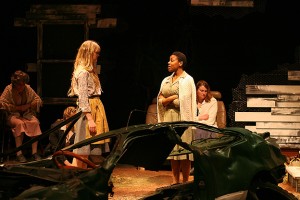Grinnell College is abuzz once more with the Grinnell College Theatre department’s spring production, “The Rimers of Eldritch.” This semester’s main-stage theatre production tells the story of a dying bible belt town, once a prosperous mining community. The plot covers the gamut of possible character roles, and does so through the view of an observant outsider forced into introspection as to what it means to be part of a community. Lanford Wilson, a native of Missouri, penned “The Rimers of Eldritch” in the early 1960s. It premiered in July 1966 in New York City. The play describes the dynamics of a small town which suffers from economic hardship and a vibrant past, both of which leave the citizens of the town pining for a bygone era. Sandy Moffett, Theatre, describes the play as acting as more of a platform on which a town is described rather than a work which tries to convey a theme of moral.

“It’s very theatrical; it’s a really interesting piece of theater. I don’t think it is a moralizing play. I don’t think it says this is what these people did wrong, or this is what ought to be done,” Moffett said.
The Rimers of Eldritch is actually not new to the Theatre department, though its flowing dialogue and social commentary have not been performed on campus in over 35 years.
“I first directed this play at Grinnell in 1974,” Moffett said. “I thought it would be really interesting to do this play again at a different time in history and look at it and see how it related to our time now as opposed to the way it related to the time when it was written. There’s really not much change. What it said, it’s still saying.”
The play employs a style of dialogue and presentation which were signature methods in the 1960s but have since waned in popularity. From the beginning, the entire cast is present on stage at all times. With a 17-member cast, keeping the audience focused on one actor while another actor sits right beside him or her is a daunting task indeed. However, the quick switching between characters actually increases the effectiveness of the dialogue by preventing time-consuming scene changes and actor shuffles.
Although fast-paced, “Rimers of Eldritch” is not a play about costumes or special effects. It is not a production with one hero or heroine or one victim and one perpetrator. Rather, it is the story of all those things within which no one character ever receives starring attention.
“It represents a type of theater that we began to see in this country in about the 60s which had a lot of really interesting ideas on how to use dialog and how to look at characters and how to build on a number of characters,” Moffett said. “The main character in this play is not one character or another. It’s the town itself. It’s a play about the town.”
It is this dialogue and intimate personal performances between actors that are both the foundations of the play and possibly its greatest weaknesses.
There are too many characters and all with equally important roles to list. However, each character or set of characters represents an emotion felt in a community. One of the largest age groups represented in the play is that of restless teenagers. The girls view their world as a cage, with the only escape being a wedding to a nice boy. The boys look back and forth between sex and becoming men and everyone else in the town constantly questions why they can’t be young again. Every mother and middle-aged shopkeeper still wonders out loud why their lives didn’t turn out the way the had planned.
Each character is invariably paired with another. An elderly mother suffering from dementia wears on her unsuccessful, professional, adult daughter. A fearful mother worries about the possibilities of her teenage daughter spending time alone with the town legend’s little brother. And everyone keeps a weary eye out for the ostracized hermit who acts as the true hero of the play but ultimately falls victim to a town’s paranoia and individual weaknesses.
The ever-awkward love scenes between the different couples do everything but romanticize the first physical encounters charged by insecurity and hormones. In one scene in particular you may find yourself shifting around thinking about how uncomfortable this is for all involved as the scene progresses from two teenagers sitting in a car to one insisting that she’ll “give it up” when the time is ready.
The play is held together by the two town gossips who act essentially as the Greek chorus, reiterating the current emotion of the scene and keeping the play moving at all times.
“My character Whilma and her counterpart Martha are like the porch talkers out of a Zora Neal Hurston novel,” said Deborah Tillman ’14.
Despite the complexities of the characters and the sheer number of people on stage at any given time, this play allows a great showcase of talent to be displayed with no one actor outshining the rest.
“This play was wonderful because it allowed so many people to bring their talent to the table. I’ve gotten to know so many new people through this experience,” said actress Caitlin Beckwith-Ferguson, ’14.




























































